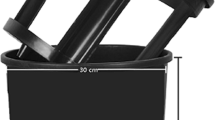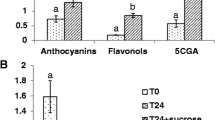Abstract
The response of four potato cultivars to various temperatures was evaluated in respect to respiration, sugar and phenolic content, and ion leakage from cut tissue sections. Respiration decreased with decreasing temperature from 20° to 0°C but after 24 hours at 0°C began to increase and reached a maximum after 10 days at 0°C, then drifted downward. No distinct break in an Arrhenius plot of the respiration data from 20° to 0°C was observed. Reducing and non-reducing sugars did not change initially between 20° and 0°C and did not increase until after 6 or 7 days at 0°C. The magnitude of the increase in sugars varied between cultivars. Only one cultivar significantly increased in phenolic content during chilling. Ion leakage remained constant from 20° to 0°C then showed a transient increase within 24 hours at 0°C. A sustained increase in leakage did not occur until after 10 days at 0°C. Cultivars varied in the rate and magnitude of the increase.
The respiratory rise could not be attributed to an increase in sugar content or an increase in membrane permeability. Also, the initial increase in sugars preceded the sustained increase in ion leakage. Differences observed between cultivars in the parameters measured were not considered sufficient to explain differences in chilling sensitivity.
Resumen
Se ha evaluado la respuesta de cuatro cultivares de papa a diferentes temperaturas en cuanto a su respiración, contenido de azúcares y fenoles y la liberatión de iones de secciones de tejidos. La respiración decreció con la disminución de la temperatura de 20°C a 0°C, pero después de 24 horas a 0°C empezó a incrementarse y alcanzar su máximo después de 10 días a 0°C, luego decreció. No se observó un rompimiento distinto en la parcela de Arrhenius de los datos de respiración de 20°C a 0°C. Los azúcares reductores y no reductores no cambiaron inicialmente entre 20°C y 0°C y no se incrementaron hasta después de 6 ó 7 días a 0°C. La magnitud del incremento de azúcares varió entre cultivares. Sólo un cultivar incremento los fenoles en forma significativa durante el enfriamiento. La liberación de iones se mantuvo constante desde 20°C a 0°C, luego mostró un incremento transitorio después de 24 horas a 0°C. No ocurrió un incremento sustancial de la liberación de iones hasta después de 10 días a 0°C. Los cultivares variaron en el rango y magnitud de este incremento.
El aumento de respiración no se pudo atribuir a un incremento del contenido de azúcar o a un incremento de la permeabilidad de la membrana. También, el incremento inicial en azúcar precedió al incremento sustancial de la liberación de iones. Las diferencias observadas entre cultivares en los parámetros medidos no fueron consideradas suficientes para explicar las diferencias en la sensibilidad al enfriamiento.
Similar content being viewed by others
Literature Cited
Amir, J., V. Kahn and M. Unterman. 1977. Respiration, ATP level, and sugar accumulation in potato tubers during storage at 4°. Phytochem 16:1495–98.
Baur, J. and M. Workman. 1964. Relationship between cell permeability and respiration in ripening banana fruit tissue. Plant Physiol 39:540–43.
Boe, A. A., G. W. Woodbury, and T. S. Lee. 1974. Respiration studies on Russet Burbank potato tubers: effects of storage temperature and chemical treatments. Am Potato J 51:355–60.
Claypool, L. L. and R. M. Keefer. 1942. A colorimetric method for CO2 determination in respiration studies. Proc Am Soc Hortic Sci 40:177–86.
Craft, C. C. 1963. Respiration of potatoes as influenced by previous storage temperatures. Am Potato J 40:289–98.
Craft, C. C., H. W. Siegelman and W. L. Butler. 1958. Study of the phenolic compound in potato tubers during storage. Am Potato J 35:651–61.
Dwelle, R. B. and G. F. Stallknecht. 1978. Respiration and sugar content of potato tubers as influenced by storage temperature. Am Potato J 55:561–71.
Effment, D., G. Meinl, and J. Vogel. 1961. Respiration, sugar level and ascorbic acid content of potato varieties at various storage temperatures. Zuechter 31:23–32.
Hendricks, S. B. and R. B. Taylorson. 1976. Variation in germination and amino acid leakage of seeds with temperature related phase change. Plant Physiol 58:7–11.
Hopkins, E. F. 1924. Relation of low temperatures to respiration and carbohydrate changes on potato tubers. Bot Gaz 78:311–26.
Hruschka, H. W., J. E. Baker, and W. L. Smith. 1968. Warming revives stored potatoes. Agric Res 17 (4): 14.
Isherwood, F. A. 1976. Mechanism of starch-sugar interconversion inSolanum tuberosum. Phytochem 15:33–41.
Johnson, G., C. Lambert, D. K. Johnson and S. G. Sunderwirth. 1964. Colorimetric determination of glucose, fructose, and sucrose in plant materials using a combination of enzymatic and chemical methods. Agric Food Chem 12:216–19.
Lewis, T. and M. Workman. 1964. The effect of low temperature on phosphate esterification and cell membrane permeability in tomato fruit and cabbage leaf tissue. Aust J Bio Sci 17:147–52.
Lieberman, M. and C. C. Craft. 1956. Metabolic and biochemical studies on the nature of chilling injury in sweet potatoes. Plant Physiol 31:XL.
Lieberman, M., C. C. Craft, and M. S. Wilcox. 1959. Effect of chilling on the chlorogenic acid and ascorbic acid content of Porto Rico sweet potatoes. Proc Am Soc Hortic Sci 74:642–68.
Lindsay, H. 1973. A colorimetric estimation of reducing sugars in potatoes with 3,5-dinitrosalicylic acid. Potato Res 16:176–79.
Lyons, J. M. and J. K. Raison. 1970. Oxidative activity of mitochondria isolated from plant tissues sensitive and resistant to chilling injury. Plant Physiol 45:386–90.
Ohad, I., I. Friedburg, A. Ne’eman and M. Schramm. 1971. The fate of amyloplast membranes during maturation and storage of potato tubers. Plant Physiol 47:465–77.
Simon, E. W. 1974. Phospholipids and plant membrane permeability. New Phytol 73:377–420.
Simon, E. W. 1977. Membranes in ripening and senescence. Ann Appl Biol 85(3):417–21.
Sparks, Walter C. 1965. Effect of storage temperature on storage losses of Russet Burbank potatoes. Am Potato J 42:241–46.
Wheeler, H. and P. Hanchey. 1968. Permeability phenomena in plant disease. Ann Rev Phytopathol 6:331–50.
Workman, M., E. Kerschner and M. Harrison. 1976. The effect of storage factors on membrane permeability and sugar content of potatoes and decay byErwinia carotovora andFusarium roseum. Am Potato J 53:191–204.
Wright, M. 1974. The effect of chilling on ethylene production, membrane permeability and water loss of leaves ofPhaseolus vulgaris. Planta 120:63–69.
Author information
Authors and Affiliations
Additional information
Scientific Journal Series Paper No. 2407 Colorado State University Experiment Station. The financial support of the San Luis Valley potato growers is gratefully acknowledged.
Rights and permissions
About this article
Cite this article
Workman, M., Cameron, A. & Twomey, J. Influence of chilling on potato tuber respiration, sugar, O-dihydroxyphenolic content and membrane permeability. American Potato Journal 56, 277–288 (1979). https://doi.org/10.1007/BF02855597
Received:
Issue Date:
DOI: https://doi.org/10.1007/BF02855597




